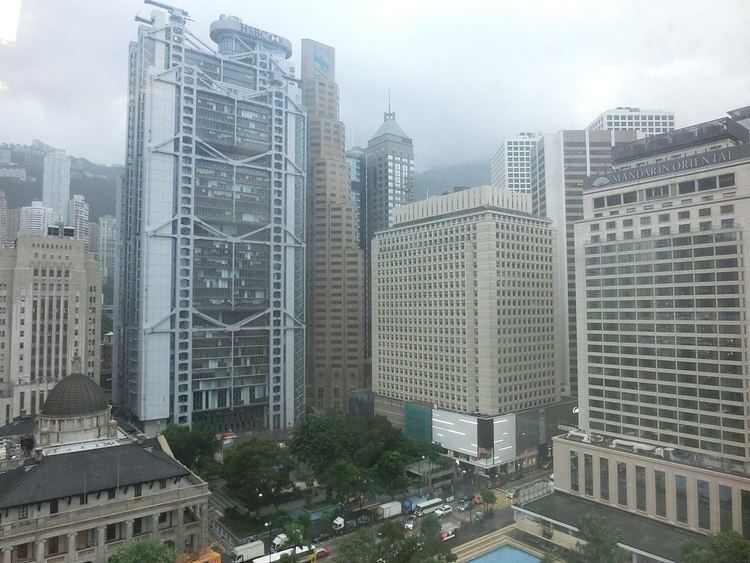 | ||
Hours Open today · Open 24 hoursMondayOpen 24 hoursTuesdayOpen 24 hoursWednesdayOpen 24 hoursThursdayOpen 24 hoursFridayOpen 24 hoursSaturdayOpen 24 hoursSundayOpen 24 hoursSuggest an edit Similar Court of Final Appeal B, Hong Kong and Shanghai, The Cenotaph, Chater Garden, Jardine House | ||
Hong kong western market central landmark statue square exchange square 1 may 2015
Statue Square (Chinese: 皇后像廣場; lit. "Empress' Statue Square") is a public pedestrian square in Central, Hong Kong. Built entirely on reclaimed land at the end of the 19th century, Statue Square consists of two parts separated by Chater Road into a northern and a southern sections. It is bordered by Connaught Road Central in the north and by Des Voeux Road Central in the south.
Contents
- Hong kong western market central landmark statue square exchange square 1 may 2015
- History
- Surrounding buildings
- The statues
- In popular culture
- References
The name is a reference to the statues, mainly of British royalty, which stood on the square until the Japanese occupation of Hong Kong during World War II. Today, the only statue on the square is the one of Sir Thomas Jackson, 1st Baronet, an early HSBC banker.
History
The square was built at the end of the 19th century on land reclaimed by the Praya Reclamation Scheme. The idea of a square of statues dedicated to royalty was conceived by Sir Catchick Paul Chater. Initially named "Royal Square", it gradually became known as "Statue Square", a name derived from the fact that it originally contained the statue of Queen Victoria, as the square's name in Chinese testifies. This statue was ordered to commemorate the 1887 Golden Jubilee of the monarch. It should not have been made in bronze, but in marble, an error that wasn't picked up until the bronze statue was almost completed. It was officially unveiled at the centre of the square on 28 May 1896, the day officially appointed for the celebration of the 77th birthday of the Queen.
A statue of Sir Thomas Jackson, 1st Baronet, the chief manager of the Hongkong and Shanghai Banking Corporation was unveiled on 24 February 1906 by the Governor Sir Matthew Nathan. At that time, the statue was facing the HSBC building. These statues (except for the statue of Jackson), together with the two bronze lions in front of the HSBC building, were displaced to Japan to be melted by the occupying Japanese during World War II.
The Cenotaph, a replica of the Cenotaph in Whitehall, London, was unveiled on 24 May 1923 (Empire Day) by the Governor Sir Reginald Edward Stubbs. It was built on the northeastern section of Statue Square, facing the Hong Kong Club Building. This area is now only uncommonly referred to as part of Statue Square.
After the war some of the statues were brought back to Hong Kong. Sir Thomas Jackson's now stands roughly in the middle of the square, facing the Court of Final Appeal Building. Queen Victoria's statue was placed in Victoria Park. The two HSBC lions are now again in front of the HSBC building. The bronze statue of George V, also removed by the Japanese, was lost and never replaced after the war.
Since the 1980s, there has been a tradition for thousands of Filipina domestic workers to congregate in and around Statue Square every Sunday (their usual rest day of the week). A parallel tradition has since been developed in Victoria Park for Indonesian domestic servants in Hong Kong.
Surrounding buildings
The HSBC Hong Kong headquarters building is located along the southern side of the square, across Des Voeux Road Central. The site was previously occupied by the old City Hall (built 1869, demolished 1933) and smaller earlier generations of the HSBC Hong Kong headquarters building.
Several buildings with names reminiscent of British royalty were built on the western side of the square. Prince's Building and Queen's Building were built directly along the square (southern section and northern section respectively), while the others were built further west.
The square was initially bordered by Victoria Harbour on its northern side, but following land reclamation, it is now separated from it by Edinburgh Place, which housed the Star Ferry pier, among others, until 2007.
The statues
Today, the only freestanding statue on the Square is the statue of Sir Thomas Jackson. Additionally, a 2.7 m high blind-folded statue of Themis, the Greek Goddess of Justice and Law, stands on top of the pediment of the Legislative Council Building, and is facing the Square. The statues that have been historically on display on the square include:
In addition, statues of royalty and colonial administrators located outside of Statue Square included:
In popular culture
This location was the pit stop for leg 10 of The Amazing Race 17.
